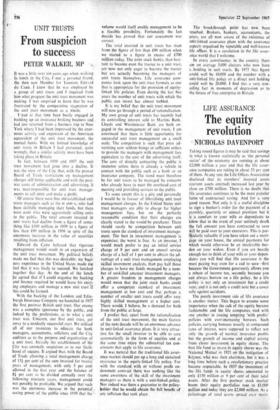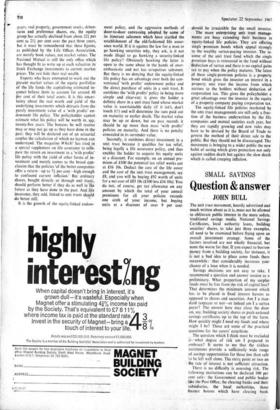The equity revolution
LIFE ASSURANCE NICHOLAS DAVENPORT
Taking round figures it may be said that savings in what is known statistically as 'the personal sector' of the .economy are running at about £2,000 million a year and that the life assur- ance companies are raking in about 35 per cent of them. At any rate the Life Offices Association disclosed that its members' invested assets (current assets omitted) increased last year by close on £700 million. There is no doubt that life assurance continues to be the most popular form •of contractual saving. And for a very good reason. Not only is it a useful discipline to sign a banker's order for the payment of a monthly, quarterly or annual premium but it is a comfort to your wife or dependants to know that in the event of your untimely death the full amount you have contracted to save *ill be paid over to your executors. This is par- titularly valuable if you have taken out a mort- gage on your house, the annual payments for which would otherwise be an intolerable bur- den on your widow. Even if you are beastly enough not to think of your wife or your depen- dants you will find that life assurance is the most paying way even for a cad to save—first because the Government generously allows you a rebate of income tax, secondly because you can always borrow on a life policy. So a life policy is not only an investment but a credit note; and it is not only a credit note but a cover tithe against accidents.
The purely investment side of life assurance is another matter. This began to assume some importance when the cult of the equity became fashionable and the life companies vied with one another in issuing tempting 'with profits' policies with ever-increasing bonuses. Snch policies, carrying bonuses usually at compound rates of interest, were supposed to reflect not Only the growth of normal insurance profits but the growth of income and capital arising from clever investment in equity shares. The first life fund to invest in equity shares was the National Mutual in 1921 on the instigation of Keynes, who was then chairman, but it was a long time before such a revolutionary practice became respectable. In 1937 the investment of the life funds in equity shares amounted to only £150 million or 9 per cent of their total assets. After the first postwar stock market boom their equity portfolios rose to £1,000 ;pillion and today they are £2,000 million. As a percentage of total assets spread over mort- gages, real property, government stocks, deben- tures and preference shares, etc, the equity group has actually declined from about 221 per cent to 211 per cent over the past three years, but it must be remembered that these figures, as published by the Life Offices Association, are merely book values, not market values. The National Mutual is still the only office which has thought fit to write up at each valuation its Stock Exchange investments to current market prices. The rest hide their real wealth.
Experts who have attempted to work out the present market values of the equity portfolios of the life funds (by capitalising estimated in- come) believe them to account for around 40 ITer cent of their total assets. It is this uncer- tainty about the real worth and yield of the underlying investments which detracts from the purely investment value of a 'with profits' en- dowment life policy. The policyholder cannot estimate what his policy will be worth in, say, twenty-five years. The bonuses he will receive may or may not go up as they have done in the past; they will be declared out of an actuarial surplus the calculation of which no layman can understand. The magazine Which? has tried? a special supplement on life assurance to com- pare the return on investment in a 'with profits' life policy with the yield of other forms of in- vestment and merely comes to the broad con- clusion that the policies 'of the better companies offer a return—up to 7-1 per cent—high enough to confound current inflation.' But ordinary shares, bought directly or through unit trusts, should perform better if they do as well in )fie future as they have done in the past. And life insurance, they add, linked to unit trusts slsquld do better still.
It is the growth of the equity-linked endow-
ment policy, and the aggressive methods of door-to-door canvassing adopted by some of its itinerant salesmen which have startled the establishment of the old-fashioned life assur- ance world. If it is against the law for a man to go hawking securities why, they ask, is it not made illegal to go hawking a security-linked life policy? Obviously hawking the latter is open to the same abuse in the hands of over- enthusiastic and not too scrupulous salesmen. But there is no denying that the equity-linked life policy has an advantage over both the con- ventionarwith profits' endowment policy and the direct purchase of units in a unit trust. It outshines the 'with profits' policy in being more simple and clear-cut; it gives the holder a definite share in a unit trust fund whose market value is ascertainable daily (if it isn't, don't touch it!) and will determine the sum paid out on maturity or earlier death. The market value may be up or down, but on past records it should be up more than most 'with profits' policies on maturity. And there is no penalty concealed in its surrender value.
Secondly, it outshines direct investment in a unit trust because it qualifies for tax relief, being legally a life assurance policy, and thus enables the holder to acquire his equity units at a discount. For example, on an annual pre- mium of £100 the potential tax relief works out at £16 10s. Deduct the cost of the life cover and the cost of the unit trust management, say £8, and you will be buying £92 worth of units for a net cost of f83 lOs MOO less f16 10s). You do not, of course, get tax' allowance on any amount by which the total of your annual premiums for all your policies exceeds one sixth of your income, but buying units at a discount of over 9 per cent should be irresistible for the small investor.
The more enterprising unit trust manage- ments are busy extending their business in equity-linked life policies. They are offering single premium bonds which appeal strongly to the wealthy surtax-paying investor. The in- come of the unit trust fund which the single premium buys is reinvested in the fund without -deduction of surtax and there is no capital gains tax to pay when the policy matures. The latest of these single-premium policies is a property bond which gives the investor an interest in a property unit trust the income from which accrues to the holders without deduction of corporation tax. This gives the policyholder a great advantage over the investor in the equity of a property company paying corporation tax.
The equity-linked life policies marketed by the unit trust managements are still only a frac- tion of the business underwritten by the life companies and mutual societies each year, but they are rapidly growing and new rules may have to be devised by the Board of Trade to govern the method of their direct sale to the public. But they should not be discouraged. The movement is bringing to a wider public the new habit of saving which gives protection not only against sudden death but against the slow death which is called creeping inflation.



































 Previous page
Previous page